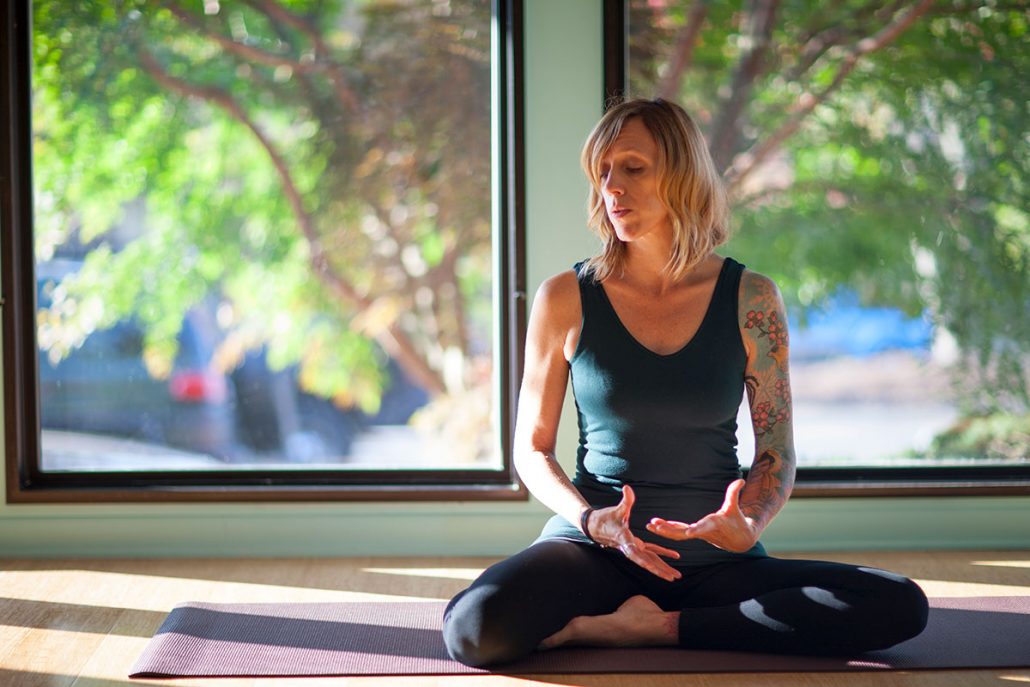The Balance of Yoga
How yoga, meditation, and mindfulness practices can help overcome anxiety and depression.
By Kimberley Puryear
Anxiety disorders are the most common mental illness in the United States, affecting over 40 million people over the age of 18 according to the Anxiety and Depression Association of America. Not surprisingly, depression and anxiety are among the primary conditions cited by those seeking help from complementary and alternative therapies, such as yoga, meditation, and mindfulness practices. The use of these modalities is on the rise, and recent studies have shown that — in addition to helping with depression and anxiety — they can also reduce the impact of stress, increase serotonin levels, and improve energy. (Read a full list of yoga benefits here.)
For most of my life I have been challenged with Persistent Depressive Disorder (PDD) which, according to the Mayo Clinic, is “a continuous long-term (chronic) form of depression.” The exact cause of PDD is unknown, but current theories suggest that it tends to run in families and occurs more often in women.
This condition affects more than 3.3 million Americans (1.5% of the U.S. population 18 years or older), but I wasn’t actually aware that PDD had a name until just a few years ago. It seems to follow certain patterns and can last anywhere from a day or two, to several months or more. Symptoms typically come and go and can be felt as mild to moderate in intensity; everything from feeling ungrounded, to feeling stuck in inertia, hopelessness, isolation, and at times feeling completely disconnected and empty.
Through lots of practice and patience, I found that both yoga asana and meditation offer the wonderful gift of ever improving awareness as well as providing the tools to work with these challenging physical and mental states. Using the body and the breath to clear, stabilize, and strengthen the mind, the feeling of balance eventually became a new habit.
Move.
As I work toward obtaining balance through the postures of yoga asana, my body becomes stronger and more flexible. My lungs receive more oxygen, and my blood flows more freely. Through these movements I identify the places in my body that are working too hard to be balanced and others that aren’t working hard enough. Moment by moment, with patience and mindful breathing, I am given the opportunity to cultivate balance. When I practice consistently, my body works and rests with greater equanimity. When I don’t practice, depression, insomnia, and inertia set in. There is a direct correlation between active movement of the body and a decrease in depression. This awareness grounds me and connects me to the earth and its energy of stability. During asana practice I am in my body, strong and centered, grounded, plugged in, and present. This stability continues off the mat with me and follows me into my daily life.
Pause.
Meditation has been proven to decrease the symptoms of depression significantly. I practice meditation to come back to a feeling of balanced attention in my mind. Isn’t “focus” the very definition of balance? When depression is present I feel unclear, stopped up, and blank. I think of the mind as if it’s a snow globe that’s constantly being shaken up. The storm of thoughts swirl around and they obstruct what’s inside, thus making it hard to see clearly. Taking some time each day to sit, settles the “snow,” empties the mind, and allows clear seeing, clear understanding, and clear presence to emerge. In meditation we practice balance through our posture and by placing our attention so that everything is stable, steady, and awake.
Breathe.
The practice of breathing brings my emotions and nervous system into a state of balance. Conscious breathing becomes a bridge that connects the body and mind together. In the exchange of inhale and exhale, I receive and release whatever arises in this moment. Sitting with the flow of moments, I connect with my most precious friend as it nourishes and cleanses my body and mind in an unbroken cycle of fragile moments. This is so healing! It softens my heart and encourages me to hold myself and all living beings with an enhanced sense of compassion.
These practices continue to be instrumental in my own healing journey, but it’s important to keep in mind that although yoga and meditation are considered to be complementary to traditional therapies, they are not meant to replace existing treatments. There’s a growing body of evidence that suggests yoga practice is a relatively low-risk, high-yield approach to improving overall mental health and well-being. There are many different yoga and meditation traditions to choose from. Find one that resonates with you. Start where you are and stick to it! Consistent practice takes time and patience. Be kind to yourself and remember this simple mantra: “Heart up, head up, chin up.”
About the Author:
Kimberley Puryear is the lead Instructor for Asheville Yoga Center’s 200-hour Teacher Training and 300-hour Advanced Training Programs. She is registered with the Yoga Alliance at both the E-RYT 200 and 500-Hour Advanced Studies levels. Kimberley’s personal practice began in 2003 as a way to deal with her mother’s illness and passing. Yoga’s ability to calm, soothe, strengthen, and heal led Kimberley to deepen her practice and understanding of this ancient science. Her love of Zen meditation, Vinyasa, and Yin Yoga have inspired her to share the healing powers of yoga and meditation with others. She practices and teaches meditation in the tradition of Thich Nhat Hahn.
Ready to beat anxiety and depression for yourself? Sign up for Kimberley Puryear’s four-week series: Yoga and Meditation for Anxiety and Depression today! Tuesdays at 5:45 p.m. starting March 29.

